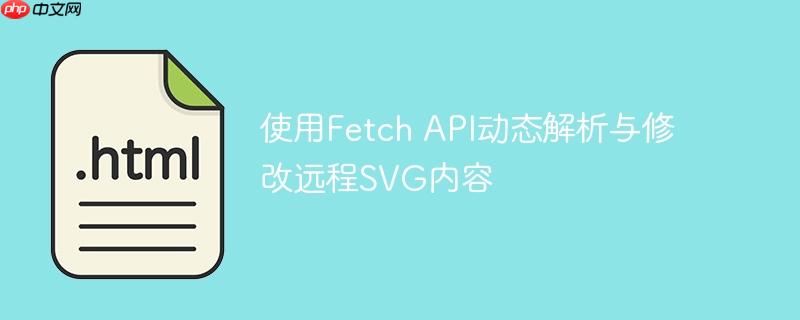
在前端开发中,我们经常需要从api获取各种资源。当api返回一个svg图像的url而非直接的内联svg代码时,如果仅仅将其作为<img>标签的src属性加载,我们将无法直接访问或修改其内部结构,例如改变路径的颜色或调整元素的大小。这对于需要动态调整svg样式的场景(如根据用户偏好更改图标颜色、动态生成带有特定数据的图表)构成了挑战。本文将深入探讨如何通过原生javascript的fetch api,将远程svg内容转换为可操作的dom元素,进而实现对其内部数据的灵活修改。
解决上述问题的关键在于,将通过URL获取到的SVG原始文本内容,动态地解析并注入到文档对象模型(DOM)中。一旦SVG内容作为DOM的一部分存在,即使是暂时的,我们就可以利用标准的DOM操作方法(如querySelector、querySelectorAll等)来访问和修改其内部的任何元素,例如<path>、<circle>、<rect>等。
下面将详细介绍如何通过几个简单的步骤,实现从URL获取SVG数据并进行动态修改。
首先,使用fetch API向SVG的URL发起请求。关键在于,我们需要将响应解析为纯文本(res.text()),而不是JSON或其他格式,因为SVG本质上是一种XML格式的文本。
const svgUrl = "https://api.qrserver.com/v1/create-qr-code/?size=150x150&data=test&format=svg";
fetch(svgUrl)
.then(response => {
if (!response.ok) {
throw new Error(`HTTP error! status: ${response.status}`);
}
return response.text(); // 获取SVG的原始文本内容
})
.then(svgText => {
// svgText 现在包含了SVG的XML字符串
console.log("Fetched SVG Text:", svgText);
// 接下来的操作将在下一节中进行
})
.catch(error => {
console.error("Error fetching SVG:", error);
});获取到SVG的文本内容后,我们需要将其“激活”为DOM元素。最简单有效的方法是创建一个临时的div元素,并将SVG文本作为其innerHTML。浏览器会自动解析这段SVG字符串,并将其内部的SVG元素转换为可操作的DOM节点。
// 承接上一步的 .then(svgText => { ... })
.then(svgText => {
const tempContainer = document.createElement('div');
tempContainer.innerHTML = svgText; // 将SVG字符串注入临时容器
// tempContainer 现在包含了可操作的SVG DOM结构
// 例如,你可以看到SVG元素本身
console.log("SVG Element:", tempContainer.querySelector('svg'));
// 接下来的操作将在下一节中进行
return tempContainer; // 将临时容器传递给下一个then
})一旦SVG内容被注入到tempContainer中,我们就可以像操作任何其他DOM元素一样,使用querySelector或querySelectorAll来查找并修改SVG内部的元素。
// 承接上一步的 .then(tempContainer => { ... })
.then(tempContainer => {
const svgElement = tempContainer.querySelector('svg');
if (svgElement) {
// 查找SVG中的所有路径(path)元素
const paths = svgElement.querySelectorAll('path');
paths.forEach(path => {
// 示例:将所有路径的填充颜色改为红色
path.setAttribute('fill', 'red');
// 示例:修改描边颜色和宽度
path.setAttribute('stroke', 'blue');
path.setAttribute('stroke-width', '2');
});
// 查找其他元素,例如一个特定的矩形
const rect = svgElement.querySelector('rect');
if (rect) {
rect.setAttribute('fill', 'green');
}
console.log("Modified SVG Element:", svgElement);
return svgElement; // 将修改后的SVG元素传递给下一个then
} else {
throw new Error("SVG element not found in the fetched content.");
}
})修改完成后,你可以选择将这个修改过的SVG元素添加到页面的某个位置,或者提取其outerHTML字符串以便于存储或进一步处理。
// 承接上一步的 .then(modifiedSvgElement => { ... })
.then(modifiedSvgElement => {
// 方式一:将修改后的SVG直接添加到页面的某个DOM元素中
const targetElement = document.getElementById('svg-display-area'); // 假设页面有一个ID为'svg-display-area'的容器
if (targetElement) {
targetElement.innerHTML = ''; // 清空原有内容
targetElement.appendChild(modifiedSvgElement);
} else {
document.body.appendChild(modifiedSvgElement); // 如果没有指定容器,则添加到body
}
// 方式二:获取修改后SVG的字符串形式
const finalSvgString = modifiedSvgElement.outerHTML;
console.log("Final SVG HTML String:", finalSvgString);
// 你也可以将这个字符串保存到本地、发送到服务器等
})
.catch(error => {
console.error("An error occurred during SVG processing:", error);
});完整示例代码:
<!DOCTYPE html>
<html lang="en">
<head>
<meta charset="UTF-8">
<meta name="viewport" content="width=device-width, initial-scale=1.0">
<title>动态修改远程SVG</title>
<style>
#svg-display-area {
border: 1px solid #ccc;
padding: 10px;
margin-top: 20px;
display: inline-block; /* 让容器适应SVG大小 */
}
</style>
</head>
<body>
<h1>动态修改远程SVG内容</h1>
<button id="loadSvgBtn">加载并修改SVG</button>
<div id="svg-display-area">
<p>点击按钮加载SVG...</p>
</div>
<script>
document.getElementById('loadSvgBtn').addEventListener('click', () => {
const svgUrl = "https://api.qrserver.com/v1/create-qr-code/?size=150x150&data=test&format=svg";
const targetElement = document.getElementById('svg-display-area');
targetElement.innerHTML = '<p>正在加载SVG...</p>'; // 显示加载状态
fetch(svgUrl)
.then(response => {
if (!response.ok) {
throw new Error(`HTTP error! status: ${response.status}`);
}
return response.text();
})
.then(svgText => {
const tempContainer = document.createElement('div');
tempContainer.innerHTML = svgText;
const svgElement = tempContainer.querySelector('svg');
if (svgElement) {
// 示例:修改SVG内部元素的颜色
const paths = svgElement.querySelectorAll('path');
paths.forEach(path => {
path.setAttribute('fill', '#007bff'); // 将填充颜色改为蓝色
path.setAttribute('stroke', '#0056b3'); // 添加蓝色描边
path.setAttribute('stroke-width', '1');
});
// 示例:修改SVG的整体尺寸 (如果需要)
svgElement.setAttribute('width', '200');
svgElement.setAttribute('height', '200');
// 将修改后的SVG添加到页面
targetElement.innerHTML = ''; // 清空加载状态
targetElement.appendChild(svgElement);
} else {
throw new Error("SVG element not found in the fetched content.");
}
})
.catch(error => {
console.error("Error during SVG processing:", error);
targetElement.innerHTML = `<p style="color: red;">加载或处理SVG失败: ${error.message}</p>`;
});
});
</script>
</body>
</html>通过Fetch API获取SVG的文本内容,并将其动态注入到临时DOM容器中,是解决无法直接修改远程SVG内容的一个强大且灵活的解决方案。这种方法利用了浏览器原生的DOM解析能力,使得我们能够像操作页面上其他元素一样,对SVG的内部结构进行精细化的控制和修改。结合适当的错误处理和安全考量,这种技术能够极大地增强前端应用对动态SVG内容的处理能力。
以上就是使用Fetch API动态解析与修改远程SVG内容的详细内容,更多请关注php中文网其它相关文章!

每个人都需要一台速度更快、更稳定的 PC。随着时间的推移,垃圾文件、旧注册表数据和不必要的后台进程会占用资源并降低性能。幸运的是,许多工具可以让 Windows 保持平稳运行。

Copyright 2014-2025 https://www.php.cn/ All Rights Reserved | php.cn | 湘ICP备2023035733号